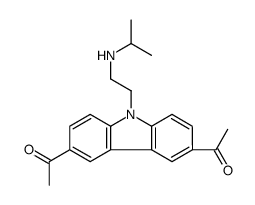| Description |
CBL0137, a curaxin compound, is a histone chaperone facilitates chromatin transcription (FACT) inhibitor. CBL0137 downregulates NF-?B and activates p53. CBL0137 restores both histone H3 acetylation and trimethylation. CBL0137 is an anticancer agent. CBL0137 induces cancer cell apoptosis[1].
|
| Related Catalog |
|
| In Vitro |
Treatment with CBL-0137 leads to complete absence of living cells at concentrations above 2.5 μM. CBL-0137 causes a greater reduction in the number of colonies formed of not only MiaPaCa-2 cells when combined with gemcitabine, but also gemcitabine-resistant PANC-1 cells. Treatment of human pancreatic cancer cells with CBL-0137 results in a dose dependent reduction of protein and mRNA levels of RRM1 and RRM2. CBL-0137 is able to prevent gemcitabine induced expression of RRM1 and RRM2 on mRNA and protein levels[1].
|
| In Vivo |
The CBL-0137 monotherapy group and the CBL-0137-gemcitabine combination group samples show large necrotic fields, numerous apoptotic bodies and loss of tumor cells. Sub-optimal doses of 50 to 60 mg/kg CBL-0137 causes similar enhancement of gemcitabine antitumor activity as that produced by the maximum tolerated dose (MTD) of 90 mg/kg as indicated by the lack of statistically significant differences among the combination groups. CBL0137 hydrochloride inhibits FACT function through depletion of the pool of active FACT involved in transcription elongation[1]. CBL-0137, given by oral gavage at a nontoxic dose of 30 mg/kg per day on a 5 days on/2 days off schedule, suppresses tumor growth in xenografts of colon (DLD-1), renal cell carcinoma (Caki-1), and melanoma (Mel-7) tumor cell lines and transplanted surgical samples from patients with pancreatic ductal adenocarcinoma[2].
|
| Kinase Assay |
MiaPaca2 and BxPC-3 cells are treated with CBL-0137for 4 or 24h. Cells are harvested in 1× Cell Culture Lysis Reagent containing protease and phosphatase inhibitors. Lysates 5 to 20 μg are separated on SDS-PAGE gels and transferred to PVDF membranes. Blots are probed with antibodies specific for SSRP1, SPT16, RRM1, and RRM2. GAPDH is used as a loading control. Proteins are visualized using ECL kit[1].
|
| Cell Assay |
Cells are resuspended in serum free Dulbecco's Modified Eagle Medium (DMEM) and treated with different concentrations of CBL-0137 for 1h. After that 105 from each treatment condition are plated in 3 wells of 6-well plate in 2mL of serum-free DMEM/F12 medium supplemented with 0.4% BSA, 0.2×B27, 10 ng/mL recombinant EGF and containing 0.25% agarose. 103 cells from each treatment condition are plated in 3 wells of 6-well plate in regular FBS containing medium. Colonies are counted using inverted microscope 7 to 15 days after plating[1].
|
| Animal Admin |
10-week old female athymic nude mice (n=8 per treatment group) are deeply anesthetized with ketamine/xylazine. Using laparotomy, 2× 106 PANC-1 cells are inoculated into the tail of the pancreas of each mouse. Two weeks following inoculation (tumor presence confirmed by ultrasound), treatment commenced. The following regimens are used: 1) vehicles, 100mg/kg captisol i.v. and sterile water via gavage, 2) 50 to 90 mg/kg CBL-0137 in 100 mg/mL captisol i.v. delivered via tail vein once per week, 3) 10 to 20 mg/kg CBL-0137 p.o. via oral gavage, 5 days on/2 days off, 4). Tumor measurement is done with digital calipers. Tumor volume is calculated using the equation L×W2/2 where L is the longest dimension and W is the dimension perpendicular to W. Mice are followed until at least one tumor per mouse reached 1000 mm3 or 90 days from start of treatment, whichever comes first[1].
|
| References |
[1]. Barone TA, et al. Anticancer drug candidate CBL0137, which inhibits histone chaperone FACT, is efficacious in preclinical orthotopic models of temozolomide-responsive and -resistant glioblastoma. Neuro Oncol. 2017 Feb 1;19(2):186-196. h [2]. Burkhart C, et al. Curaxin CBL0137 eradicates drug resistant cancer stem cells and potentiates efficacy of gemcitabine in preclinical models of pancreatic cancer. Oncotarget. 2014 Nov 30;5(22):11038-53. [3]. Ehteda A, et al. Dual targeting of the epigenome via FACT complex and histone deacetylase is a potent treatment strategy for DIPG. Cell Rep. 2021 Apr 13;35(2):108994.
|
